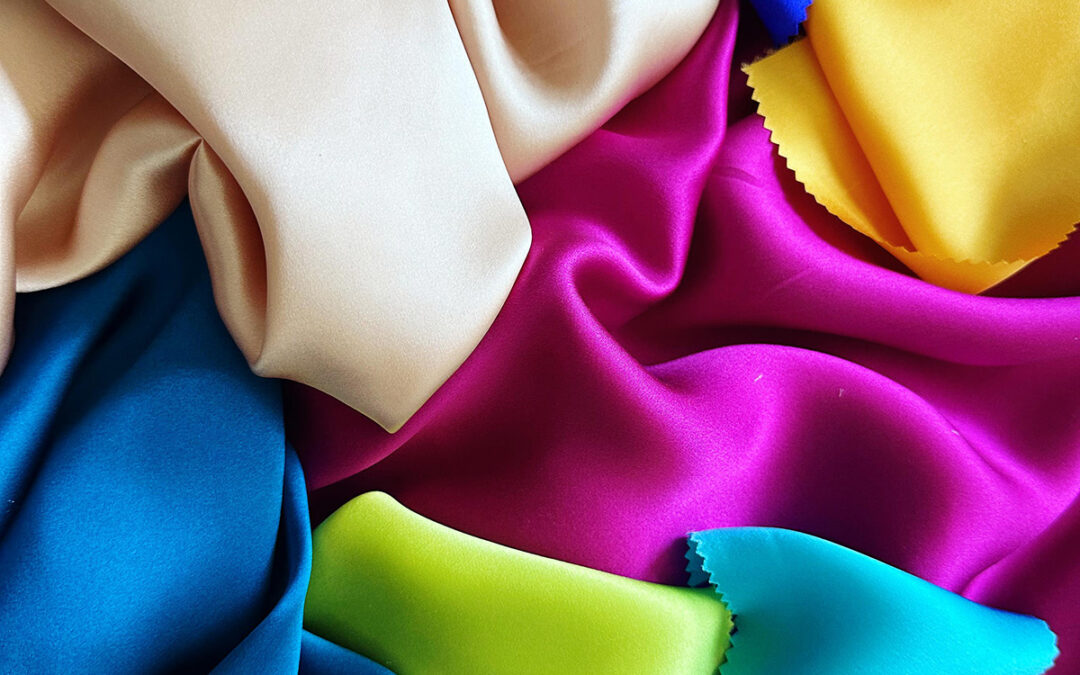The different silk fabrics obtainable with various processes can be classified based on weaving, weight, finish and characteristics.
Based on weaving, silk fabrics can be divided into:
- Satin fabrics: have a smooth, lustrous surface, with a shiny appearance on one side and a matte appearance on the other. Taffeta, satin and brocade are examples of satin silk fabrics.
- Canvas fabrics: Have a smooth, even surface, with a shiny appearance on both sides. Chiffon, duchesse and shantung are examples of plain silk fabrics.
- Twill fabrics: have a surface with a diagonal weave, which gives the fabric a more robust and resistant appearance. Matelassé, tweed and faille are examples of silk twill fabrics.
- Crêpe fabrics: Have an irregular surface, with a wavy or wrinkled appearance. Crêpe de Chine, crêpe Georgette and crêpe georgette are examples of crêpe silk fabrics.
Based on weight, silk fabrics can be divided into:
- Lightweight fabrics: They are thin and delicate, weighing less than 100 grams per square meter. Chiffon, duchesse and shantung are examples of lightweight silk fabrics.
- Medium fabrics: have a weight between 100 and 200 grams per square meter. Taffeta, satin, and brocade are examples of medium silk fabrics.
- Heavy fabrics: These are thick and sturdy, weighing more than 200 grams per square metre. Matelassé, tweed and faille are examples of heavy silk fabrics.
Based on the finish, silk fabrics can be divided into:
- Natural fabrics: These are untreated silk fabrics, with their natural shine and softness.
- Dyed fabrics: These are silk fabrics dyed with a variety of colors.
- Printed fabrics: These are silk fabrics decorated with printed patterns.
- Treated fabrics: These are silk fabrics that have undergone special treatments to improve their characteristics, such as wear resistance, dimensional stability, or stain protection.
Based on their characteristics, silk fabrics can be divided into:
- Comfortable fabrics: These are silk fabrics that are soft and breathable, suitable for day wear.
- Elegant fabrics: These are silk fabrics that are lustrous and refined, suitable for evening wear.
- Functional fabrics: These are silk fabrics that are strong and durable, suitable for sports or workwear.
Here are some examples of silk fabrics obtainable with various processes:
- Taffeta: smooth and shiny silk fabric, obtained with a satin weave.
- Chiffon: Lightweight, sheer silk fabric made from plain weave.
- Crêpe de Chine: light and soft silk fabric, obtained with a crêpe weave.
- Satin: smooth and shiny silk fabric, obtained with a satin weave.
- Brocade: silk fabric with decorative motifs in relief, obtained with a particular weave.
- Twill: Silk fabric with a diagonal weave, obtained with a twill weave.
- Matellassé: Silk fabric with a relief pattern, obtained through a quilting process.
- Tweed: silk fabric with a ribbed texture, obtained with a twill weave.
- Faille: silk fabric with a wavy surface, obtained with a crepe weave.
Silk is a very versatile natural fiber, which can be used to create a variety of high-quality fabrics. The different processes to which it can be subjected make it possible to obtain fabrics with characteristics and properties suitable for different applications.
